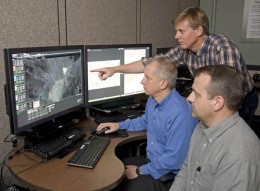((Contributed by Timothy R. Gaffney))
Picture this video game scenario: Intruders have broken into a sprawling military base. Your challenge is to find them by searching the ground with a camera mounted in a high-flying unmanned air vehicle.
Sound simple? It isn’t. You have to keep suspicious objects within the highly zoomed image on your screen while the camera platform – the UAV – constantly moves to counteract gusts of wind or make turns on its course.
Now imagine having to steer cameras simultaneously on two different airplanes… or three. Add an unmanned ground vehicle to the mix. Oh, and you also have to keep track of all the vehicles and make sure they don’t collide or crash.
This is no video game. It’s the goal of an Air Force research program aimed at allowing a single operator to manage several unmanned vehicles – some in the air, some on the ground – all at the same time.
The key is to allow the vehicles to control themselves and work cooperatively, freeing the human to supervise what they do.
Operating multiple vehicles at once is an impossible task for a single unassisted human, says David Gross, Ph.D., a Wright State Research Institute engineer with more than 200 hours operating UAVs.
Steering the camera on just one UAV takes intense concentration and quickly fatigues an operator, says Gross, the Research Institute’s Chief Engineer for Systems Integration and Test. “After about 20 minutes, you’re done,” he says. “You couldn’t control two cameras at the same time and worry about the flight paths of two vehicles. You couldn’t do it.”
But that’s exactly what the Air Force Research Laboratory is learning how to do in a program it calls ICE-T, for Intelligent Control and Evaluation of Teams. And not just with unmanned air vehicles, but ground vehicles as well.
The use of UAVs for information gathering and in combat is surging. And, while UAVs have nobody on board, every UAV needs one or more operators on the ground. The result is a growing manpower demand in a time of tight budgets.
The capacity to use UAVs cooperatively – sharing tasks and coordinating activities – expands their range of capabilities and makes better use of limited human resources. The ICE-T program has demonstrated ways to make that capacity real. Its goal is to develop technology that can be applied to future operational systems.
Located on Wright-Patterson Air Force Base near Dayton, Ohio, the program is a collaborative effort by two major AFRL directorates, Air Vehicles and Human Effectiveness, with Infoscitex Corp. as prime contractor. Wright State Research Institute, a part of Wright State University, is a subcontractor to Infoscitex. Gross is the program’s principal investigator.
The heart of ICE-T is a bundle of computer programs executing algorithms that the Air Vehicles Directorate develops to automate many of the control functions of a human UAV operator.
The face of ICE-T is a ground station called Vigilant Spirit, which the Human Effectiveness Directorate developed to research ways for humans to supervise teams of unmanned vehicles. The dominant visible element is a big computer screen with displays of fancy graphics and video feeds.
“What we’re trying to do is provide a capability that enables one operator to control multiple vehicles in situations where it makes sense,” says Gregory L Feitshans of the Human Effectiveness Directorate. Feitshans is the Vigilant Spirit Control Station Chief Engineer. “With this ground station and the associated algorithms, one operator can control multiple vehicles,” he says.
Researchers use Vigilant Spirit to test algorithms by flying simulated UAVs in a virtual world. But it isn’t limited to that. “We can pretty much disconnect our network cable and go do a flight test. The commands are pretty much the same going to a real vehicle as going to a simulated vehicle,” Feitshans says.
“For years and years we just published research papers, but in order to have anybody believe it’s going to work, you have to go out and test it,” says Mark Mears, Ph.D., AFRL’s ICE-T program manager.
“If you did all this research just in a simulation, there’s a lot of things you’d miss from a real vehicle,” Gross adds.
Gross has managed all of ICE-T’s flight-testing, first under a previous contractor and since 2009 with the Wright State Research Institute. The tests range from simple hardware trials to participation in major military exercises, including the massive, international Talisman Saber exercises in Australia in 2007 and 2009.
ICE-T researchers also demonstrated the technology to Air Force security forces last year at Vandenberg Air Force Base in California. That was where the video-game scenario came up, with one operator supervising a mix of unmanned air and ground vehicles to hunt for make-believe intruders.
But the algorithms running in the Vigilant Spirit work station transformed the operator into a supervisor, directing the action with a mouse instead of juggling joysticks.
“It’s a significant improvement in operator workload.” Gross says.


 Milling around
Milling around  Wright State recognizes Nursing Professor Kim Ringo for advancing international student success
Wright State recognizes Nursing Professor Kim Ringo for advancing international student success  Wright State honors graduating students for distinguished doctoral dissertations
Wright State honors graduating students for distinguished doctoral dissertations  Top 10 Newsroom videos of 2025
Top 10 Newsroom videos of 2025  Museum-quality replica of historic Hawthorn Hill donated to Wright State
Museum-quality replica of historic Hawthorn Hill donated to Wright State 